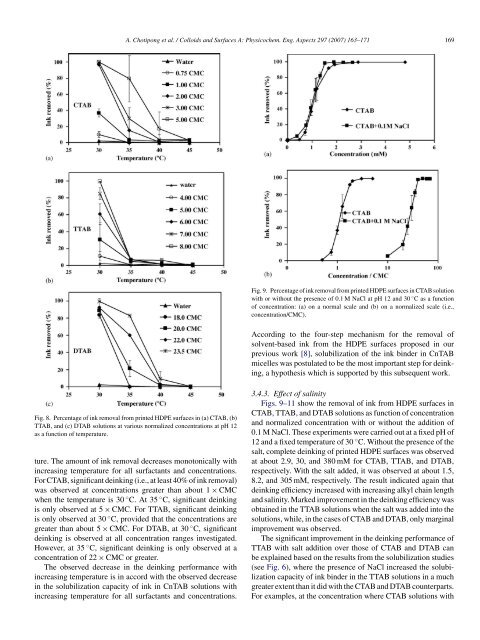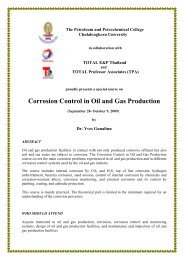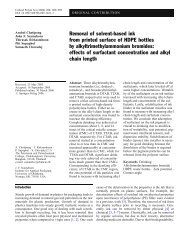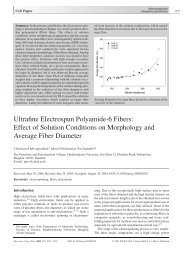Removal of solvent-based ink from printed surface - The Petroleum ...
Removal of solvent-based ink from printed surface - The Petroleum ...
Removal of solvent-based ink from printed surface - The Petroleum ...
Create successful ePaper yourself
Turn your PDF publications into a flip-book with our unique Google optimized e-Paper software.
A. Chotipong et al. / Colloids and Surfaces A: Physicochem. Eng. Aspects 297 (2007) 163–171 169<br />
Fig. 8. Percentage <strong>of</strong> <strong>ink</strong> removal <strong>from</strong> <strong>printed</strong> HDPE <strong>surface</strong>s in (a) CTAB, (b)<br />
TTAB, and (c) DTAB solutions at various normalized concentrations at pH 12<br />
as a function <strong>of</strong> temperature.<br />
ture. <strong>The</strong> amount <strong>of</strong> <strong>ink</strong> removal decreases monotonically with<br />
increasing temperature for all surfactants and concentrations.<br />
For CTAB, significant de<strong>ink</strong>ing (i.e., at least 40% <strong>of</strong> <strong>ink</strong> removal)<br />
was observed at concentrations greater than about 1 × CMC<br />
when the temperature is 30 ◦ C. At 35 ◦ C, significant de<strong>ink</strong>ing<br />
is only observed at 5 × CMC. For TTAB, significant de<strong>ink</strong>ing<br />
is only observed at 30 ◦ C, provided that the concentrations are<br />
greater than about 5 × CMC. For DTAB, at 30 ◦ C, significant<br />
de<strong>ink</strong>ing is observed at all concentration ranges investigated.<br />
However, at 35 ◦ C, significant de<strong>ink</strong>ing is only observed at a<br />
concentration <strong>of</strong> 22 × CMC or greater.<br />
<strong>The</strong> observed decrease in the de<strong>ink</strong>ing performance with<br />
increasing temperature is in accord with the observed decrease<br />
in the solubilization capacity <strong>of</strong> <strong>ink</strong> in CnTAB solutions with<br />
increasing temperature for all surfactants and concentrations.<br />
Fig. 9. Percentage <strong>of</strong> <strong>ink</strong> removal <strong>from</strong> <strong>printed</strong> HDPE <strong>surface</strong>s in CTAB solution<br />
with or without the presence <strong>of</strong> 0.1 M NaCl at pH 12 and 30 ◦ C as a function<br />
<strong>of</strong> concentration: (a) on a normal scale and (b) on a normalized scale (i.e.,<br />
concentration/CMC).<br />
According to the four-step mechanism for the removal <strong>of</strong><br />
<strong>solvent</strong>-<strong>based</strong> <strong>ink</strong> <strong>from</strong> the HDPE <strong>surface</strong>s proposed in our<br />
previous work [8], solubilization <strong>of</strong> the <strong>ink</strong> binder in CnTAB<br />
micelles was postulated to be the most important step for de<strong>ink</strong>ing,<br />
a hypothesis which is supported by this subsequent work.<br />
3.4.3. Effect <strong>of</strong> salinity<br />
Figs. 9–11 show the removal <strong>of</strong> <strong>ink</strong> <strong>from</strong> HDPE <strong>surface</strong>s in<br />
CTAB, TTAB, and DTAB solutions as function <strong>of</strong> concentration<br />
and normalized concentration with or without the addition <strong>of</strong><br />
0.1 M NaCl. <strong>The</strong>se experiments were carried out at a fixed pH <strong>of</strong><br />
12 and a fixed temperature <strong>of</strong> 30 ◦ C. Without the presence <strong>of</strong> the<br />
salt, complete de<strong>ink</strong>ing <strong>of</strong> <strong>printed</strong> HDPE <strong>surface</strong>s was observed<br />
at about 2.9, 30, and 380 mM for CTAB, TTAB, and DTAB,<br />
respectively. With the salt added, it was observed at about 1.5,<br />
8.2, and 305 mM, respectively. <strong>The</strong> result indicated again that<br />
de<strong>ink</strong>ing efficiency increased with increasing alkyl chain length<br />
and salinity. Marked improvement in the de<strong>ink</strong>ing efficiency was<br />
obtained in the TTAB solutions when the salt was added into the<br />
solutions, while, in the cases <strong>of</strong> CTAB and DTAB, only marginal<br />
improvement was observed.<br />
<strong>The</strong> significant improvement in the de<strong>ink</strong>ing performance <strong>of</strong><br />
TTAB with salt addition over those <strong>of</strong> CTAB and DTAB can<br />
be explained <strong>based</strong> on the results <strong>from</strong> the solubilization studies<br />
(see Fig. 6), where the presence <strong>of</strong> NaCl increased the solubilization<br />
capacity <strong>of</strong> <strong>ink</strong> binder in the TTAB solutions in a much<br />
greater extent than it did with the CTAB and DTAB counterparts.<br />
For examples, at the concentration where CTAB solutions with





